I Sunday Mirror Trophy
Goodbye my ol' friend
Author
- Lorenzo Baer
Date
- October 2, 2025
Related articles
- Goodwood - Bruce McLaren's mastery of the Sussex track, by Mattijs Diepraam
Who?Jim Clark What?Lotus-Climax 33 Where?Goodwood When?I Sunday Mirror Trophy (April 19, 1965) |
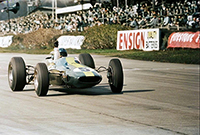 |
Why?
A racetrack can tell many stories: Spa-Francochamps, with its curves through the heart of the Ardennes, or the Nürburgring, with its descents and ascents through the Eifel mountains. Also Monaco, where champions were crowned and underdogs made history, on the shores of the glamorous Cote d’Azur. But it is not only the temples of speed that constitute the memory of motorsport, with other places also actively contributing to the preservation of the traditions of sport worldwide.
It is worth mentioning one of them, which has a special connection with any lover of the history of car racing: Goodwood. Despite not having a flashy history as some of its counterparts mentioned above, the track located in the heart of West Sussex has become the world's epicentre of historic motor racing due to the various meetings that the venue hosts annually, like the famous Goodwood Revival and the Festival of Speed.
Even though it is mostly remembered for contemporary historical events, Goodwood also has its 'historical legacy', so to speak. Officially opened in 1948, the venue was part of the British picturesque club meeting scene in its early years, before eventually transforming into an internationally recognised circuit. First with the Goodwood Nine Hours, then becoming the home of the traditional Tourist Trophy, the track grew exponentially in importance, until its abrupt cessation of activities in 1966.
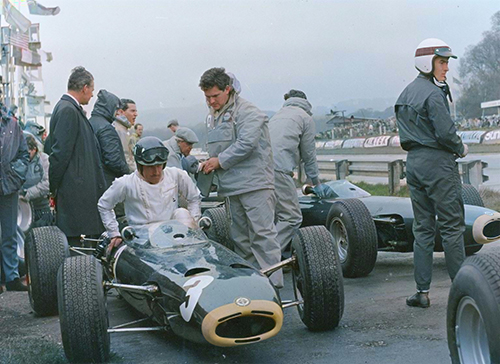
Pre-race preparations: Graham Hill and Jackie Stewart make final adjustments in the tight Goodwood pit box.
(credits Simeone Foundation, colourised by the author)
Although all these events helped build the fame that Goodwood would experience in the following decades, none come close to the popularity that existed when the most prestigious category in world motorsport definitively landed at the location. The sound and appeal of Formula One cars was something special for any motorsport enthusiast of the time, and when the circuit located in the bucolic city of Chichester became a recurring stop for the category, in the early 1950s, Goodwood would never be the same.
It became the turning point for the venue, which catapulted Goodwood definitively into the annals of world motorsport. Between 1950 and 1965, the track was a mandatory stop for F1, and when the closure of the track was announced in 1966, feelings of surprise and sadness became the common denominators for those who saw or competed in so many races at the site.
Because of this, the 1965 race had a bittersweet taste for those who last (officially) witnessed the friendly F1 cars on that charming British circuit. At the same time, it was a sign that the new times called for greater safety and care when carrying out Formula races, but on the other hand it was a melancholic farewell to a place that had contributed so much to the valorisation of the category on the British Isles.
A short story of single-seater racing at Goodwood
In a country with numerous circuits of international level and relevance, it is to be expected that Goodwood will not be immediately recognised for its most complex contribution to British single-seater motorsport. Tracks like Silverstone, Brands Hatch, Oulton Park and Crystal Palace generally steal the spotlight for the F1 events they hosted, even though many of them were almost irrelevant compared to the vast scale of motorsport and the category today.
Because of this, it is worth asserting the importance of Goodwood in the assimilation of single-seater competition as a valid and accessible discipline in a British context after the war – which was completely different from the one that existed until the end of the 1930s. By the late 40s, circuits such as Donington Park and Brooklands had become just a memory in a distant past, due to the technological boom of the post-war.
Firstly, it is necessary to correctly define the lineage of the trophies contested for and by single-seater cars on the Goodwood circuit. The first is the Lavant Cup, contested between 1949 and 1966, and which was without a doubt the second most important event for single-seaters at Goodwood. The Lavant Cup had its greatest moment between the mid-1950s and early 1960s, when contested in an Formula Libre format, being won by drivers such as Jack Brabham, Roy Salvatori and Bruce McLaren. However, from 1963 onwards, the Lavant Cup became a competition held exclusively for sports cars, losing much of its continental appeal at this time.
Another single-seater event, quite unknown in Goodwood's history, was the Madwick Cup, which happened for a short period of time (1948 to 1954). Despite being theoretically a Formula 2 event, in reality, the race was run under F Libre regulations as well, with 500cc Coopers racing against 2000cc Ferraris in a handicap format. Despite being well attended, the Madwick Cup was removed from the calendar when it became clear that it was unfeasible to hold three major races on the venue.
This brings us to the third and most important single-seater trophy of Goodwood. Known by several names – firstly as the Goodwood Trophy, then Richmond Trophy, progressing to Glover Trophy and finally, News of the World Trophy, this was the race that would definitively mark the pinnacle of the circuit, in the commercial, economic and competitive spectrums.
Disputed for the first time on September 18th, 1948, the Goodwood Trophy marks a milestone little recognised today: of being the first important single-seater race contested on a closed circuit on the British Isles after the war. Until then, all races had been contested on street circuits. For example, Silverstone would host its first official meeting just a month later, as the British GP. In this fashion, Goodwood hosted its first semi-official single-seater event, with events for the 500cc category (snatched by a certain Stirling Moss in a Cooper MkII) and Formula Libre (won by Reg Parnell in a Maserati 4CLT/48).
The following year, another reasonably successful meeting and, in 1950, the first major change in the structure of the event took place. A special trophy was commissioned for the race, which would later give the name to basically all F1 races held there: the Glover Trophy. Ordered by Mr D.M. Glover, chairman of United Lubricants Ltd. (later known as United Oil Products Ltd. – or simply, UOP), the Glover Trophy was introduced as a way of recognising the winner of the 500cc race, which was considered, until then, the most important event of the calendar of races at Goodwood.
Despite the trophy gaining a greater mystique than the race itself, the unofficial name 'Glover Trophy' had to share, over the following years, its naming rights with the commercial names applied to the race. For example, between 1950 and 1952, when the race was still contested by 500cc F3 machines, the event was officially known as the 500 International Trophy Race, always taking place on Whit Monday.
The years 1953 and 1954 were a transitional period in the trophy, when the 500 International Trophy Race and the Richmond Trophy (another single-seater event held at Goodwood) were integrated, forming the Richmond & Glover Trophy. As the Richmond Trophy was a race already open to F Libre cars, a category above 500cc F3, it was decided that this would now be the contested formula for the Glover Trophy. It was also at this time that the race was relocated to Easter Sunday, the traditional date to which it would be tied over the following years.
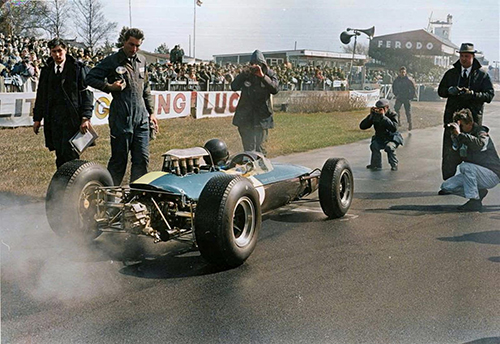
All eyes on me! The Team Lotus was one of the big attractions at the Goodwood event.
(credits unattributed, colourised by the author)
The next important step in this confusing journey was when the Richmond & Glover Trophy was officially elevated to the status of a non-championship F1 event, starting in 1955. This first event was won by Roy Salvadori in a Gilby Engineering Maserati 250F, and it was at this point that the race had finally reached the highest possible international standard.
A new change in the nomenclature of the race in 1958, when it would become the Goodwood International 100, would mark a great moment of stability and prosperity for the event, with names like Hawthorn, Surtees and Hill marking their names in the history of the Glover Trophy. For example, it was at this time that the only recognised two-time champions of the trophy emerged: Stirling Moss (1956/'59 editions) and Innes Ireland (1960/'63 events).
However, in the early sixties, not everything was as perfect as it seemed for the Glover Trophy. One of the main problems the event faced was the direct competition of the Grand Prix de Pau, another non-championship F1 race that always took place on the same date as the British meeting (Easter Sunday). Obviously, Goodwood could not match up in a direct confrontation with Pau, as the French race enjoyed greater historical prestige, as well as superior economic power - factors that the BARC, co-organiser of the Glover Trophy races, could never match.
This tug of war, which compromised the symbiotic development of the two events, had its noticeable effects in the races of 1960/'61/'62. While Ferrari, Lotus, RRC Walker and Porsche preferred to compete at Pau, Cooper, BRM and Brabham sided with Goodwood. However, 1963 was the last straw for the British, when a negligible entry list of ten cars was presented by the organisers of the Glover Trophy for that year's edition of the event – something that basically declared the French triumph in the duel.
The prospects for the 1964 edition of the Goodwood International 100 looked even grimmer once D.M. Glover lost his interest in sponsoring the event. However, when the race's death seemed imminent, two strokes of luck saved the event at the last moment. The first was the interest from the British News of the World tabloid in taking over the naming rights for the race, a deal that came to fruition at some point in late 1963. This would inject a crucial amount of resources into Goodwood, guaranteeing the continuity of the Glover Trophy lineage for at least one more year.
The second important point was when the organisers at Pau decided to 'rethink' the race, moving it from non-championship F1 status to a leg of the European F2 championship. This had a collateral impact, given that in order to meet the FIA and FFSA requests the race had to be slotted into another weekend, adapting to the pre-existing F2 calendar. This left Goodwood as the only international single-seater race on the Easter weekend – something that pleased organisers and teams equally.
The big test was the 1964 edition of the Glover Trophy, which was now officially called the I News of the World Trophy. Representatives from Lotus, Owen/BRM, Cooper, RRC Walker, Centro Sud and other well-known squads from the F1 circus converged in West Sussex, bringing the Goodwood circuit to life once again. Jim Clark's dominant victory probably wasn't the most exciting in the history of motorsport, but it was certainly essential in putting the Goodwood name back in the headlines of the sport's specialised newspapers.
Therefore, even more was expected for the 1965 event, which had undergone yet another name change to I Sunday Mirror Trophy while the race was preparing for its swansong. A historic moment, one that would certainly appeal to many of those who had been part of Goodwood's history.
The entry list
Due to the change of dates, there were no longer valid reasons for teams to refuse to participate in the Goodwood Easter event, and therefore all the great players of the time sent their main representatives. Lotus, BRM, Cooper and Brabham dispatched their official squads, supported by a series of smaller teams, which helped to reach a good number of 18 registered entries for the race.
The big disappointment came on account of Ferrari which despite having shown initial interest in participating in the event did not actually enter its vehicles in the race, largely due to Enzo Ferrari's lack of enthusiasm in participating in British pre-season events, which always left Maranello's red cars as a subject of speculation and doubt when such events were held. Even so, the names of the British giants were enough to compensate for the lack of the Scuderia's machines on the grid.
Eyes were focused especially on the Team Lotus cars. Although reasonable, Jim Clark's third place in the 1964 F1 World Championship was not good enough for Colin Chapman's high standards, and the team soon set to work for what was expected to be an overwhelming 1965. Expectations were initially met with Mike Spence taking the team's first success of the year in the Race of Champions in mid-March, while Clark had done his part in the XIV Gran Premio di Siracusa.
Two victories in two races seemed to be the sign of auspicious times ahead for the team, and for Goodwood, Lotus was expected to continue their streak. Jim Clark led the team in another season, once again equipped with a Climax-engined Lotus 33, even though the car had not been able to demonstrate its full potential in 1964, due to numerous mechanical problems that hampered the car's performance.
However, history changed in 1965, with pre-season victories by Spence and Clark changing the fortunes of the 33. For Goodwood, Lotus offered two packages for its drivers: for Clark, a Type 33 chassis fitted with a new 32-plug V8 engine, the newest creation of Coventry Climax. In contrast, Mike Spence would have to make do with a Lotus 33 equipped with the 1964 version of the Climax V8 – something that by no means meant too much of a disadvantage for the Briton.
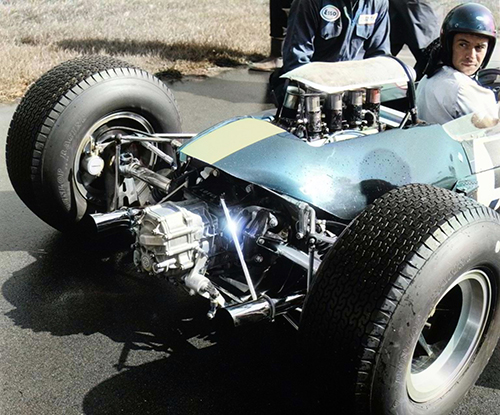
Clark's new 32-plug V8 engine shines in the rear compartment of the Lotus 33.
(credits unattributed, colourised by the author)
But it wasn't just Lotus that drew attention upon its arrival at Goodwood. The Owen Racing Organisation-run BRM team appeared with a strong lineup for the event, composed of veteran Graham Hill and the newest favourite of the British crowd, a young Jackie Stewart. Following Richie Ginther's departure from BRM at the end of 1964 to join Honda, the second seat in the Bourne-based team became the most coveted position in motorsport at the time.
Stewart had already left his mark in F3 (for Tyrrell) and F2 (for Ron Harris) and it became inevitable that the driver would become the most likely to inherit the American's seat at BRM. When the Scot arrived at the team, the scene was also one of frantic preparation for the season that was approaching on the horizon. After the great disappointment for Owen Racing Organisation/BRM in 1964, which saw an almost guaranteed title slip through their fingers at the end of the season, the promise of a solid lineup coupled with a more reliable car should once again take the team to the top of the standings.
Hill and Stewart's mount was aesthetically the same as the 1964 one, based on the BRM P261 chassis. However, a major internal overhaul promised to remedy most of its reliability issues, which had been the car's Achilles heel in the second half of the 1964 season. Also, the BRM P56 1.5 V8 engine finally started to sound healthy again, promising to be a challenge to the Climaxes that equipped most of BRM's rivals.
Among them were Brabham and Cooper. The first had a reasonable year in 1964, winning two races of the F1 world championship with American Dan Gurney. Even though it wasn't the worst of all worlds, Jack Brabham wasn't completely satisfied with his team's performance that year, especially given the unsatisfactory performance of the BT11 model (since Gurney's victories were achieved with an older type, the BT7).
Because of this, 'Black Jack' reinforced his incentives for the BT11, installing it as the team's main equipment for 1965. Unfortunately for the Australian ace, this decision did not prove to be auspicious in the pre-season races. In the Race of Champions, both Brabham (oil leak) and Gurney (ignition problems) failed to complete the full length of the race. Therefore it was hoped and expected that Brabham would bring something better than what his cars had demonstrated in the months preceding Goodwood.
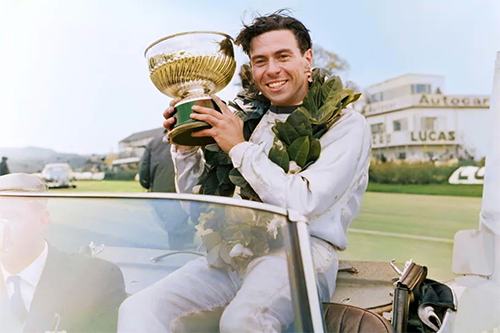
Clark would be the big name that Easter weekend at Goodwood: in addition to winning the Sunday Mirror Trophy, the driver would also lift the Lavant Cup and the St. Mary's Trophy trophies. (credits Daily Mirror, colourised by the author)
If the Brabham team had its fair share of issues, Cooper was in even worse shape – a winless year like 1964 was definitely one to forget, and all the team wanted was to move on. The Cooper T73 had been a huge fiasco, and it was expected that the T77 model, introduced at the Race of Champions, would be the answer for a resurgence of the legendary Cooper Car Company in F1. Even though the car itself was a huge question mark, it was indisputable that the drivers representing the team were of high calibre, as Bruce McLaren led the young Jochen Rindt in one of the most interesting pairings at the Goodwood event.
Even if the big teams stole all the crowd's attention, it would be the smaller teams that would add volume to the field of entries for the I Sunday Mirror Trophy. The main one was undoubtedly the Rob Walker Racing Team, F1's legendary multiple race-winning privateer. Composed of the Joakim Bonnier (Brabham-Climax BT7) and Joseph Siffert (Brabham-BRM BT11) duo, the team was probably the only satellite team with greater aspirations in the race.
Two other small teams also lined up two-car squads: DW Racing Enterprises, with British driver Bob Anderson (Brabham-Climax BT11) and Australian Paul Hawkins (Lotus-Climax 33), and Bob Gerard Racing, with John Taylor (Cooper-Climax T60) and John Rhodes (Cooper-Ford T71/73). Rhodes' car deserves a special mention since in reality it was a hybrid built from parts from a Cooper T71 (F2) and a T73 (F1) and equipped with a Ford Twin-Cam engine.
Rounding-up the entry list were the teams that would send just one representative to the West Sussex countryside. The traditional Reg Parnell Racing team had thrown all its weight behind Richard Attwood and the team's ageing Lotus-BRM 25 while both Robert Ashcroft Racing and Sports Motors Manchester bet on their ultra-light F Libres to balance the scales with the heavyweights F1s. Each equipped with their own Brabham BT14 1600cc Ford Twin-Cam, they hoped that with John Cardwell and Rodney Bloor, respectively, they would be able to surprise their rivals. It was also expected that John Willment Automobiles, which had registered Frank Gardner in the entry list, would appear at the event, but in the end neither the team nor the Australian driver attended the meeting.
BRM x Lotus: the battle begins
Official activities at the circuit would begin on Saturday with the official practice sessions for the various categories that would make up the Goodwood Easter meeting schedule. In addition to F1, which was the cherry on the top of the cake that weekend, there would also be races for Formula 3, saloon cars, touring cars and sports cars. As always, time was a rare commodity in an event with so many categories in its portfolio, and track time was perfectly timed across all categories.
The F1 cars began to enter the track early in the afternoon, with every driver trying to impress the crowd. In particular, both BRM and Lotus soon demonstrated that they had the strongest cars for the weekend, as Clark and Spence put up a magnificent fight against Hill and Stewart. Because of this, the quartet had no problem in breaking Clark's record lap achieved the previous year at 1.21.
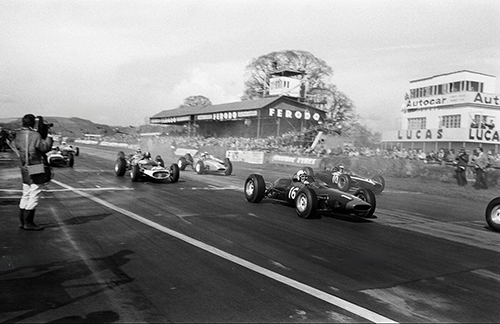
The start: 16 cars race down the main straight of the Goodwood circuit for the 1st Sunday Mirror Trophy.
(credits unattributed)
Jackie Stewart stood out the most in just his third race for BRM. The Scot set a very strong pace, giving his rivals no chance of responding. At the end of the session, the best time and the right to start in first place on the I Sunday Mirror Trophy grid belonged to the young driver with a time of 1.19.8. Stewart's BRM teammate had also done well, as Graham Hill set a consistent pace to record a time of 1.20.6, enough to guarantee him second place on the grid.
Also having done a 1.20.6 lap was Clark, who had to settle for third due to having set this time after Hill. Right behind and on the second row of the grid were Mike Spence and the surprising Bob Anderson, who was another that managed to dive below the previous track record with a time of 1.20.8. The big disappointment of the day was Jochen Rindt, who proved to be the worst of the frontrunners, as the Austrian would start from a modest 13th position.
On an Easter Monday...
After a Sunday without activities due to Easter, all the drivers gathered for their moment of truth on Monday at Goodwood: it was time for the race. 18 cars and drivers were prepared in the pits, while the other races of the day took place on the West Sussex tarmac. It should be noted that this development was a close call, given that in the early hours of the morning few expected that the Goodwood Easter Meeting would actually happen.
Opening the day, the F3 race was scheduled to take place, which would feature names like Gethin, Courage and Cardwell. The problem is that the weather was a crucial factor at the start of the race, when a strong storm hit the circuit. With visibility completely compromised, the BARC decided to suspend the race until conditions improved. The consequence of this was that when the contest was resumed, the entire timetable for the day was jeopardised. Because of this, the second race of the day, open to saloon cars, was considerably reduced, bringing the schedule back to its pace again.
Even with all the delays and setbacks, the BARC organisers managed the feat of keeping to the timetable, and at 3pm, the I Sunday Mirror Trophy would kick off. After more torrential rain, the signal was given for the F1 cars to line up in their respective starting positions.
In front of a crowd of 50,000 people who resisted the cold and the incessant rain that fell on Goodwood, 18 cars would make history as the last F1 cars to compete in an official race in the category on the mythical track. When the starting signal was given, it was every man for himself, amid a blinding cloud of water raised by the tyres of the machines that roared on the British circuit.
Graham Hill took the lead, followed by Jim Clark, who would be the only Team Lotus representative in the race, as Mike Spence's car suffered problems with its fuel injection system even before lining up on the starting grid. Jackie Stewart had dropped to third, with Dan Gurney, Jack Brabham and Bruce McLaren following closely behind. Bob Anderson had a terrible start, dropping from fifth to seventh before the first corner, and by the end of the lap, the driver was in eighth after also having been overtaken by Jo Bonnier.
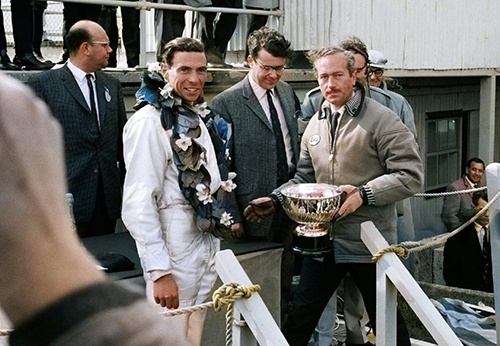
A scene that would become common throughout 1965: Colin Chapman and Jim Clark sharing the top spot on the podium. (Credits: Mirrorpix, colourised by the author)
Before Lavant corner, the general picture of the I Sunday Mirror Trophy was outlined, as Clark and Hill were separating themselves from the main pack, while Stewart would have to fight several intense battles to get rid of the experienced drivers close behind. In his first direct fight, Stewart didn't have much luck, as he lost third place to Dan Gurney, who was upping his pace to catch up to the leaders.
By the end of the first of the 42 laps of the I Sunday Mirror Trophy, the top five positions were as follows: 1st Graham Hill; 2nd Jim Clark; 3rd Dan Gurney; 4th Jackie Stewart; 5th Bruce McLaren. In the following laps, the action was divided between confrontations that took place all through the field, as Hill held on despite continuing attacks from Clark, who clearly had a better car than his BRM rival. Behind, Gurney and Stewart tried to close the gap to the leaders, while Brabham, McLaren and Bonnier fought over fifth. Further back, a small group formed by Siffert, Rindt and Anderson was established.
However, on lap 5, the great moment of the race occurred, as at Woodcote, Jim Clark took advantage of a moment of neglect from Graham Hill to execute a beautiful manoeuvre to take the lead. Hill was undeterred and gave chase to the Lotus driver. However, Hill's momentum didn't last long as Clark was quick to grasp the opportunity, building a gap between the two.
At the end of lap 10, it was clear that the race would be decided between the first four cars. Jim Clark had an advantage of a few seconds over Hill, who was now beginning to worry less about chasing the leader than about the threat that was coming from behind. Gurney was now the second fastest driver on track (the exception obviously being Jim Clark) and the difference between the Brabham and the BRM was getting smaller every moment.
At the 15-lap mark, that threat had become reality, with Gurney showing a strong interest in Hill's second place. On the other hand, the American's approach was good for Hill as well, as it allowed Jackie Stewart to reconnect with the battle for third place. Therefore, while Gurney was aiming for Hill's spot, the American also had to worry about the rival, as the driver was literally sandwiched between the two BRMs.
The laps followed one another, and apathy fell on Goodwood. The middle part of the race had arrived, and little action was taking place on the track. With the exception of some occasional overtaking moves, the only things that attracted the crowd's attention were the spectacular accidents of Bob Anderson and Jo Siffert. The first, on lap 23, was caused by braking problems at the final Goodwood chicane and Anderson ended up cutting it off from the outside, as the driver tore off part of the secondary protection that existed at the site (a net that contained debris and vehicles that could head towards the public) and ended up being disqualified for that.
The second had his incident in the same place five laps later. But unlike the Briton, Siffert collided with the chicane itself (which at the time was a low wall built of bricks), causing a strong impact that almost completely destroyed his BT11. Fortunately, in both cases, the drivers emerged with minor bruises.
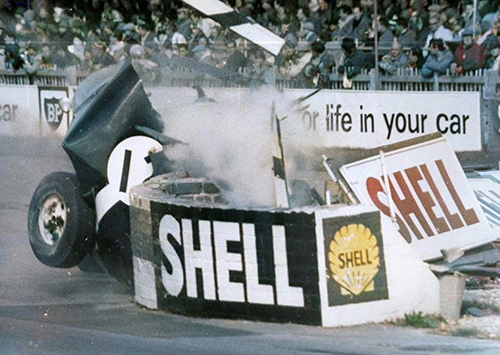
Siffert's spectacular accident caught on camera. (credits Goodwood Estate, colourised by the author)
Reflecting on the on-track situation, such incidents served to definitively fragment the midfield of the race. Jochen Rindt's disqualification on lap 29 due to cutting the chicane in the same way as Anderson only served to worsen the situation for the midfield drivers, who had now completely lost some of their benchmarks in the race.
However, returning to the front of the pack, an interesting move occurred on lap 26, when Dan Gurney finally managed to snatch second position from Hill. Jackie Stewart, who now found himself behind his teammate, was initially resigned to following the BRM hierarchy. However, seeing Gurney slipping away over the horizon and feeling he was faster than the #3 BRM, Stewart overtook Hill and began the hunt for Gurney's Brabham.
Therefore, from lap 32 onwards, a new picture was created at Goodwood. Clark had opened up a gap of more than 20 seconds to the now second-placed Dan Gurney, who was now being chased by a fast Jackie Stewart. Hill didn't push his car too much, hoping that problems for his rivals would once again place him in a privileged position in the race.
Due to a double stroke of luck, the driver's strategy ended up working out in the end, as on lap 37, both Gurney and Stewart experienced terminal failures on their machines. The Scot, right at the beginning of the lap, broke one of the camshafts of the BRM engine, putting an end to his ambitions in the race while the American lasted a little longer on the lap, reaching as far as St. Mary's and Lavant when his oil pressure plummeted, packing up the car's engine almost immediately.
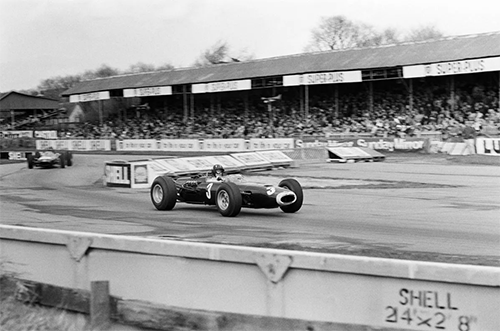
Hill's almost superhuman effort to bring the damaged BRM home paid off, with the driver achieving a well-deserved second-place finish in the race. (credits unattributed)
The sudden problems of the two drivers basically sealed the fate of the race, as in the following laps any threat that still existed to Clark's victory dissipated. The Scot almost paraded to the finish line, crossing the 42 laps of the race in a total time of 57.33.8. 15 seconds behind was Graham Hill in a struggling BRM. It was found in a post-race inspection that Hill's car would not have lasted another couple of laps, due to failures of several spark plugs in the BRM V8 engine.
Rounding out the podium was Jack Brabham, who had a discrete but steady race to a distant but deserving third position. Completing the final classification, we had in order (only cars still running at the final flag): 4th Bruce McLaren; 5th Jo Bonnier; 6th Richard Attwood; 7th John Taylor; 8th John Rhodes.
Goodwood: a history and a legacy
There is some debate as to whether Jim Clark's wins in 1964 and 1965 should be counted toward the overall Glover Trophy tally, or whether they should be considered separate wins from the trophy's original lineage. The arguments on the one hand (that the discontinuation of the Glover Trophy from 1963 onwards meant the end of this title as well) and on the other (there was no official 'interruption' between the editions of the Glover/News of The World/Sunday Mirror events) are both valid, so it is impossible to make a personal judgment in the case.
The closest we can get to a verdict on the case is the BARC's position about the case, which considers Jim Clark's victories as separate achievements, not linked to the legacy of the original Glover Trophy, something that strangely diverges from the criteria used to recognise the winners of the Lavant Cup. In the end, it all depends on the reader's perspective more than anything else. Perhaps the only unanimous fact is that the Scot definitively put his name in the annals of Goodwood after 1965, being one of the few drivers to win two F1 races at the venue.
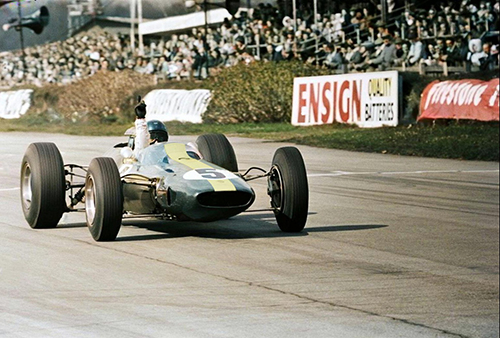
A winner's celebration: the Lotus 33 finally proved its worth to Clark. (credits Alamy, colourised by the author)
For the British track, well... this was a memorable goodbye to the pinnacle of the sport. However, as a small relief from this pain, pleasant news would soon reach the ears of Goodwood lovers, as for 1966, the agreement between the track and the News of the World tabloid would be renewed, with the latter committed to promote another race at the place.
With the impossibility of attracting F1, F2 was responsible for carrying the II Sunday Mirror Trophy – and it did not disappoint. Despite the absolute dominance of the Brabham team, with their BT18s equipped with 800cc Honda engines, teammates Jack Brabham and Denny Hulme provided the crowd with an electrifying duel that lasted a good part of the 42 laps. In the end, 'Black Jack' emerged as the winner, but only four tenths ahead of the Kiwi.
And so ended Goodwood's original history as a single-seater racing venue. But like everything in life, goodbye may not mean something forever - in the end, it might be just a farewell…
